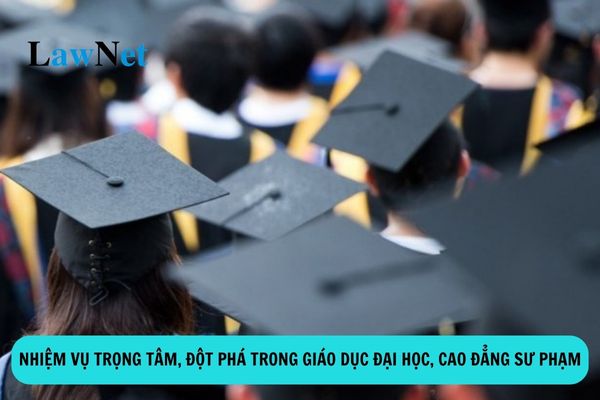5 key and breakthrough tasks for higher education and pedagogical colleges in the school year 2024 - 2025 in Vietnam
5 key and breakthrough tasks for higher education and pedagogical colleges in the school year 2024 - 2025 in Vietnam
According to Section 1 of Official Dispatch 4606/BGDDT-GDDH of 2024 on the implementation of tasks for the 2024-2025 school year concerning higher education and teacher training colleges, the five core, breakthrough tasks are as follows:
(1). Finalize development strategies, streamline organizational structures, and mobilize all resources to enhance university governance capabilities, strengthen quality assurance conditions, complete and develop internal quality assurance systems, and improve operational indicators of each training institution, fully meeting the criteria of the university education standards.
(2). Drastically innovate programs and training methods linked to strengthening management, improving the quality of human resource training, and scientific research capabilities, particularly in key fields and sectors according to regional and local development orientations.
(3). Enhance the application of digital technology, especially artificial intelligence, throughout the higher education system, linked to administrative reform, innovation in management and school governance methods, teaching and learning methods, examinations, and evaluations, creating positive impacts for general education reform.
(4). Promote training, retraining, attracting, and developing a team of high-level lecturers, scientists, and leading experts, especially in several critical, key, high-tech sectors.
(5). Efficiently implement tasks, well prepare projects according to the action programs of the Government of Vietnam, to implement the resolutions of the Central Committee and the Politburo; strategies, planning, programs, and projects approved by the Prime Minister, particularly focusing on the development of high-quality human resources for high-tech industries of Vietnam, focusing on semiconductor chip industries, artificial intelligence, cybersecurity, biotechnology, and green energy.

5 key and breakthrough tasks for higher education and pedagogical colleges in the school year 2024 - 2025 in Vietnam (Internet image)
Is strengthening training, attracting, and developing the teaching staff a specific task for higher education and teacher training colleges in the 2024 - 2025 school year in Vietnam?
According to Section 2 of Official Dispatch 4606/BGDDT-GDDH of 2024, one of the specific tasks for the 2024-2025 school year for higher education and teacher training colleges is strengthening training, attracting, and developing the teaching staff, especially for STEM fields and other key industries; focusing on retraining and enhancing core competencies for lecturers. To be specific:
- Review and plan for the development of the teaching staff, meeting the standards of higher education institutions and training program standards for various fields and sectors, ensuring the conditions for opening programs, consistent with admission and training scales.
- Utilize scholarship sources, create conditions, and implement necessary supportive measures for more lecturers to pursue advanced studies, particularly doctoral education under Scheme 89; prioritizing lecturers in STEM fields to support the development of high-tech and other key sectors of the country.
- Develop policies for working, assessing, and rewarding lecturers based on qualifications, competencies, job positions, and performance results to attract, retain, and develop excellent lecturers, especially in sectors with strong competition with the industrial sector for talent attraction.
- Enhance the training, retraining, and create conditions for lecturers to self-train and enhance their foreign language skills, pedagogical capabilities, organizational skills, research implementation abilities, and advanced technology application in teaching and learning, especially digital technology and artificial intelligence.
- Teacher training colleges focus on educating a new source of high-quality educational human resources, while prioritizing activities to enhance capabilities for teachers and educational management staff towards standardization, meeting the requirements of educational reform.
Is encouraging the development of high-tech fields one of the specific tasks for higher education and teacher training colleges in the 2024 - 2025 school year in Vietnam?
According to Section 2 of Official Dispatch 4606/BGDDT-GDDH of 2024, one of the specific tasks is as follows:
4. Innovate, modernize programs and training methods, better meet the demand for high-quality human resources of the labor market and the diverse learning needs of learners in the new context
a) Review, innovate, modernize training programs according to the training program standards, particularly considering the incorporation of subjects or embedding content into training programs that meet the development needs of fields and industries according to approved strategies, programs, and projects[1].
b) Promote international cooperation, corporate cooperation to innovate, update goals, program content, teaching and learning methods, assessment of learning outcomes; encourage the development of interdisciplinary training programs, especially in STEM fields to serve the development of high-tech, key areas such as information and communication technology, artificial intelligence, semiconductor chips, automation, biotechnology, and green energy.
c) Diversify training methods, collaborate to pilot digital higher education models, strongly apply digital technology, especially artificial intelligence in educational activities; promote cooperation with enterprises in advanced training, skills transformation for workers. Focus on developing or opening new talent training programs in fields prioritized for investment by the state, tied to the actual needs of society.
d) Expand the teaching and learning of foreign languages in courses and training programs currently conducted in Vietnamese, establishing a roadmap to make English the second language in schools, promoting international integration and attracting foreign students to study.
One of the specific tasks in higher education and teacher training colleges is encouraging the development of interdisciplinary training programs, especially in STEM fields to serve the development of high-tech, key industries such as information and communication technology, artificial intelligence, semiconductor chips, automation, biotechnology, and green energy.

